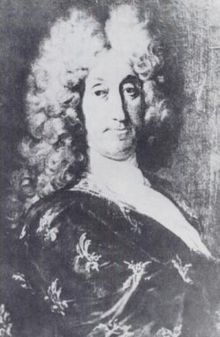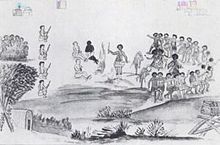- Christoph von Graffenried
-
Christoph von Graffenried (1661, Worb, Canton of Bern – 1743) led a group of Swiss and Palatine Germans to North Carolina in 1705, and later authored Relation of My American Project, an account of the establishment of this colony in the New World.
Contents
Early life
The well-to-do patrician family originally established themselves in the neighborhood of Bern at the time of the founding of the city on the Aar river in 1191 by Berchtold V, Duke of Zaringen.[1]
Christoph von Graffenried was born November 15, 1661 at the family home, Schloss Worb, in Worb, in the German-speaking part of the Canton of Bern in Switzerland, the eldest son of Anton von Graffenried (1639–1730) and Katarina Jenner (? -1669).
On April 25th, 1684, Graffenried married Regina Tscharner (1665–1731). Regina also came from an accomplished and respected family, her father, Beat Lewis Tscharner, having been a member of the Assembly and her grandfather, Samuel Tscharner, having been Governor and later Mayor of Chillon. Regina and Christoph had four sons and seven daughters. In 1702, he acquired the position as bailiff of Yverdon.
The New World
Graffenried met Franz Ludwig Michel who had discovered silver mines in Virginia and owned land in the New World. He told Graffenried what glorious places North Carolina and Virginia were and he advised him to move to North Carolina. With the idea of paying off his debts and making money on the cheap land in North Carolina, Graffenried left his debts to his father and secretly departed for London so that he could see this New World.
When in London, Graffenried had met with John Lawson who was publishing a book entitled A Voyage to Carolina. Lawson was the Surveyor General of North Carolina. Lawson promised to show Graffenried and his settlers a perfect place to establish a community. In 1709, Graffenried then met with the Lords Proprietors of Carolina who granted to him ten thousand acres (40 km²) on the Neuse and Cape Fear Rivers.[2] The also gave him the title Baron of Bernberg, after the settlement he was supposed to found. Consequently, Graffenried gathered a group of Germans from the Palatine region and Swiss immigrants. They had faced hardships in their own countries and wanted to start over in North Carolina. He sailed to North Carolina in 1710. On the sea, the settlers were attacked by French privateers who stripped them of everything they brought.
Once in the New World, the settlers sold everything that remained, except the clothes on their backs. John Lawson took them to a site at the junction of the Trent and Neuse Rivers, which they named New Bern. The first season, the settler's crops did not do well. Graffenried returned to Europe to get supplies and additional settlers. He returned to the colony unscathed.
In addition to a lack of food and supplies, there was great tension between the settlers and the Tuscarora Indians of the Neuse River region. Unknown to the settlers, their new settlement was on the site of an old Tuscarora Indian village. In 1711, Graffenried and the settlers evicted a group of Tuscarora from nearby lands without payment, and Graffenried assumed the title "Landgrave of Carolina." Retaliatory raids by the Tuscarora, under a leader named Hancock, led to deaths and damage to the settlement.
During the summer of 1711, Graffenried, along with John Lawson, took a trip up the Neuse River. Graffenried wanted to crossbreed European grapes with wild, native grapes and start a vineyard. The Tuscarora Indians took Graffenried and John Lawson (and a slave who was carrying the baggage) captive.
While in captivity, John Lawson and Graffenried were given three separate trials, each in a different Tuscaroran village. One found the men not guilty; the other two pronounced them guilty of wrongful crimes against the Tuscarorans. The Tuscaroras decided to kill them, but the elders talked and decided Graffenried would be released. He wore such fine clothes they mistook him for the governor of North Carolina. They thought if they let the "governor" go, the colony would let the incident pass. They informed him they were planning an attack on all the settlements in North Carolina (this came to be known as the Tuscarora Indian War). The next day, Lawson was killed and Graffenried was allowed to return to his settlement, which he found abandoned and in flames.
Return to Bern
Graffenried had lost his fortune and returned to Bern, Switzerland in 1714. Graffenried was penniless and owed a great deal of money to the people of North Carolina. He sold his part in the North Carolina town to Thomas Pollock for 800 pounds. In an attempt to pay off his debts, Graffenried soon wrote a book entitled "Relation" as an apology and explanation as to why his settlement failed. He included several documents, among them a letter written to the governor of North Carolina and a layout of the settlement of New Bern. An artist, he included sketches of early colonial North Carolina. Graffenried also talked about how Lawson brought his death upon himself. He said that Lawson was a money grubbing land speculator and that he thought Lawson wanted the colony to fail because he was the one that told them about the land. Graffenried died unhappy and in debt in 1743.
References
- ^ Graffenried, Christoph von in German, French and Italian in the online Historical Dictionary of Switzerland.
- ^
 "Graffenried, Christopher". New International Encyclopedia. 1905.
"Graffenried, Christopher". New International Encyclopedia. 1905.
- Vincent H. Todd, Editor (1920) Christoph von Graffenried's Account of the Founding of New Bern. Publications of the North Carolina Historical Commission, Raleigh, N.C.: Edwards & Broughton
- Swiss Roots: Christoph von Graffenried
Further reading
 "Graffenried, Emanuel, Baron de". Appletons' Cyclopædia of American Biography. 1900.
"Graffenried, Emanuel, Baron de". Appletons' Cyclopædia of American Biography. 1900.- Albert Bernhardt Faust, The German Element in the United States (2 vols.), Boston: Houghton Mifflin Co., 1909, v. 1, pp. 212–213.
Categories:- 1661 births
- 1743 deaths
- People from Worb
Wikimedia Foundation. 2010.


